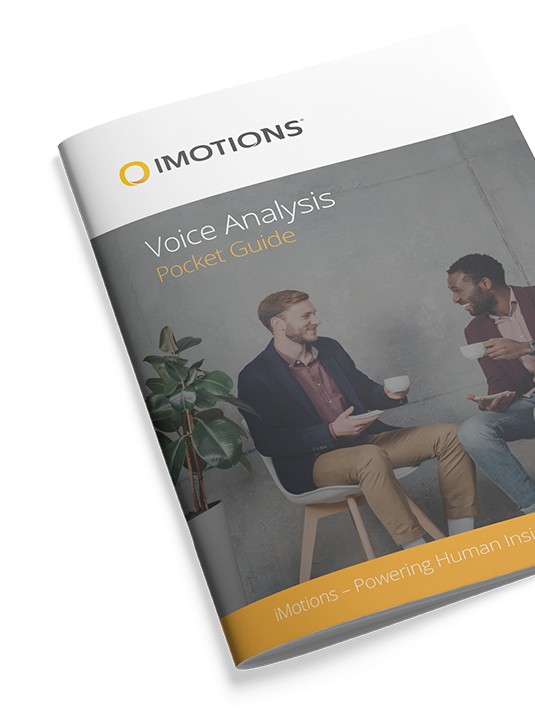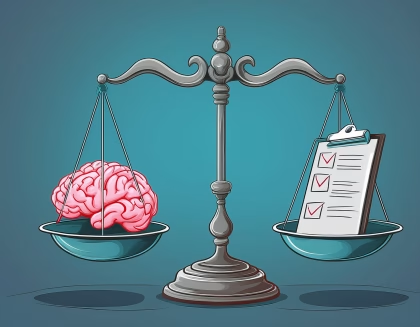Explore the world of emotional prosody with iMotions’ latest update. Uncover how speech unveils human emotions beyond words, through pitch, rhythm, and intonation. Dive into this comprehensive guide to understanding and leveraging emotional prosody in behavioral research.
With the implementation of voice analysis in the iMotions Software portfolio, a new valuable avenue in emotion analysis and research has opened to iMotions users. The emotional dimension of speech can reveal new layers of vocal communication in respondent testimonies and give new dimensions to research studies. The layer of speech that contains the emotions is called emotional prosody or, sometimes, affective prosody. In this article, we will look at what emotional prosody is and how it can be leveraged in behavioral research.
In essence, emotional prosody is the study of how we convey and perceive emotions through the acoustic features of speech. It involves the modulation of pitch, rhythm, and intonation to express sentiments beyond the literal meaning of words.
This aspect of communication plays a crucial role in understanding the nuanced layers of human expression. In this exploration, we’ll examine the mechanics of emotional prosody, its impact on our daily interactions, and its significance in deciphering the true emotional intent behind spoken language.
Defining Emotional Prosody?
Within the field of linguistics, affective and human behavior sciences, emotional prosody pertains to the modulation of various acoustic parameters in speech, including pitch, rhythm, intensity, and duration, to convey affective states. This phenomenon represents a non-lexical aspect of language that facilitates the expression and recognition of emotional content in spoken communication.

Emotional prosody serves as an intricate and nuanced communicative channel, operating synergistically with semantic content to convey a richer, emotionally charged dimension to verbal expression. The study of emotional prosody encompasses both the production and perception of these acoustic modulations, contributing to a comprehensive understanding of the interplay between linguistic and emotional processes in human communication.
The Role of Pitch in Emotional Prosody
Pitch, perhaps the most prominent element of emotional prosody, plays a pivotal role in signaling emotional states. Numerous studies have demonstrated the association between pitch variations and specific emotions. For instance, increased pitch range and higher average pitch are often linked to positive emotions such as joy or excitement, while a flatter pitch contour may indicate negative emotions like sadness or anger (Juslin & Laukka, 2003; Scherer, 1986).
Rhythm and Timing in Emotional Expression
The rhythmic aspects of speech, including tempo and timing, contribute significantly to emotional prosody. Speaking at an accelerated tempo might convey enthusiasm or urgency, while a slower pace may signify contemplation or sadness. The deliberate use of pauses can also serve as a powerful tool, influencing the emotional impact of speech by creating moments of tension or emphasis (Livingstone & Thomson; 2009).
Research has shown a correlation between the frequency of pauses, silent and vocalized, and truthfulness, suggesting heightened cognitive monitoring during deceptive communication. Although no findings definitively establish that increased pausing in deceptive speech directly results from heightened cognitive load, this hypothesis gains support when examining specific pause categories. Notably, localized deception is more associated with the use of vocal pauses such as saying “um” than “uh,” showcasing distinctive characteristics such as prolonged temporal duration, preceding latency intervals, and inclusion within contexts marked by extended silent pauses.
In the realm of prosodic features, loudness surpasses rudimentary pitch-related features in influencing speech veracity. Preliminary insights propose investigating the prosodic interplay between filled pauses and their context while machine-learning outcomes advocate an integrative approach, combining static and dynamic features from filled pauses with additional prosodic, lexical, and subject-specific attributes to enhance predictive efficacy (Benus et al: 2006).
Intensity and Duration as Emotional Modulators
Intensity and duration serve as potent emotional modulators within the realm of emotional prosody, influencing the perceptual and communicative aspects of spoken emotions. Intensity, reflected in variations of loudness, adds a dynamic layer to emotional expression, amplifying or attenuating the emotional impact of speech. A heightened intensity may convey enthusiasm or anger, while a subdued intensity can signify sadness or tranquility.
The duration of prosodic elements, encompassing the length of sounds, pauses, and overall speech patterns, further contributes to the nuanced portrayal of emotions. Prolonged vowels, elongated pauses, or rapid speech rates all shape the temporal landscape of emotional prosody, allowing for subtle distinctions in emotional nuances. Together, intensity and duration act as powerful tools, shaping the melodic contours of speech and providing a canvas for the intricate expression of a wide array of emotions in human communication.

Cross-Cultural Variations and Individual Differences
Cross-cultural variations and individual differences play pivotal roles in shaping the landscape of emotional prosody, revealing the dynamic interplay between cultural contexts and unique personal attributes. Across diverse cultures, the expression and interpretation of emotions through prosody exhibit distinct patterns, reflecting the nuanced ways in which societies foster emotional communication. Cultural norms, linguistic nuances, and historical context intertwine to mold the tonal nuances and rhythmic cadence of emotional prosody, influencing how individuals perceive and convey feelings through speech.
Simultaneously, individual differences contribute a rich layer of complexity to emotional prosody. Factors such as personality traits, cognitive styles, and even individual life experiences can modulate how people express and interpret emotions acoustically. For instance, an extroverted individual may exhibit more pronounced prosodic variations in their speech, while someone with a reserved disposition might convey emotions more subtly. These individual differences underscore the intricate web of factors that shape emotional prosody, highlighting the need for a holistic understanding that considers both cultural and individual dimensions. In unraveling the tapestry of emotional prosody, acknowledging these variations becomes essential for grasping the full spectrum of how emotions are woven into the fabric of human communication.
Practical Applications and Implications
Understanding emotional prosody extends beyond theoretical curiosity, finding practical applications in fields such as human-computer interaction, artificial intelligence, and clinical psychology. Emotional prosody recognition in speech synthesis systems, for example, contributes to the development of more natural and emotionally resonant virtual assistants. In clinical settings, the analysis of emotional prosody aids in the diagnosis and treatment of various psychological disorders, including autism spectrum disorders and mood disorders (Paulmann & Uskul, 2014).
Conclusion
Emotional prosody serves as a crucial link between people as well as a captivating bridge between linguistics and psychology, unraveling the intricate ways our voices encode and decode emotions. As researchers continue to probe the depths of this fascinating domain, the implications for improving our understanding of human communication and enhancing technological applications are boundless.
Free 22-page Voice Analysis Guide
For Beginners and Intermediates
- Get a thorough understanding of the essentials
- Valuable Voice Analysis research insight
- Learn how to take your research to the next level

References:
- Juslin, P. N., & Laukka, P. (2003). Communication of emotions in vocal expression and music performance: Different channels, same code? Psychological bulletin, 129(5), 770. https://psycnet.apa.org/record/2003-99991-007
- Livingstone, S. R., & Thompson, W. F. (2009). The emergence of music from the Theory of Mind. Musicae Scientiae, 13(2_suppl), 83-115. https://journals.sagepub.com/doi/10.1177/1029864909013002061
- Benus, S., Enos, F., Hirschberg, J., & Shriberg, E. (2006). Pauses in Deceptive Speech. https://doi.org/10.7916/D8SQ97TG
- Paulmann, S., & Uskul, A. K. (2014). Cross-cultural emotional prosody recognition: Evidence from Chinese and British listeners. Cognition and Emotion, 28(2), 230-244.https://pubmed.ncbi.nlm.nih.gov/23862740/











